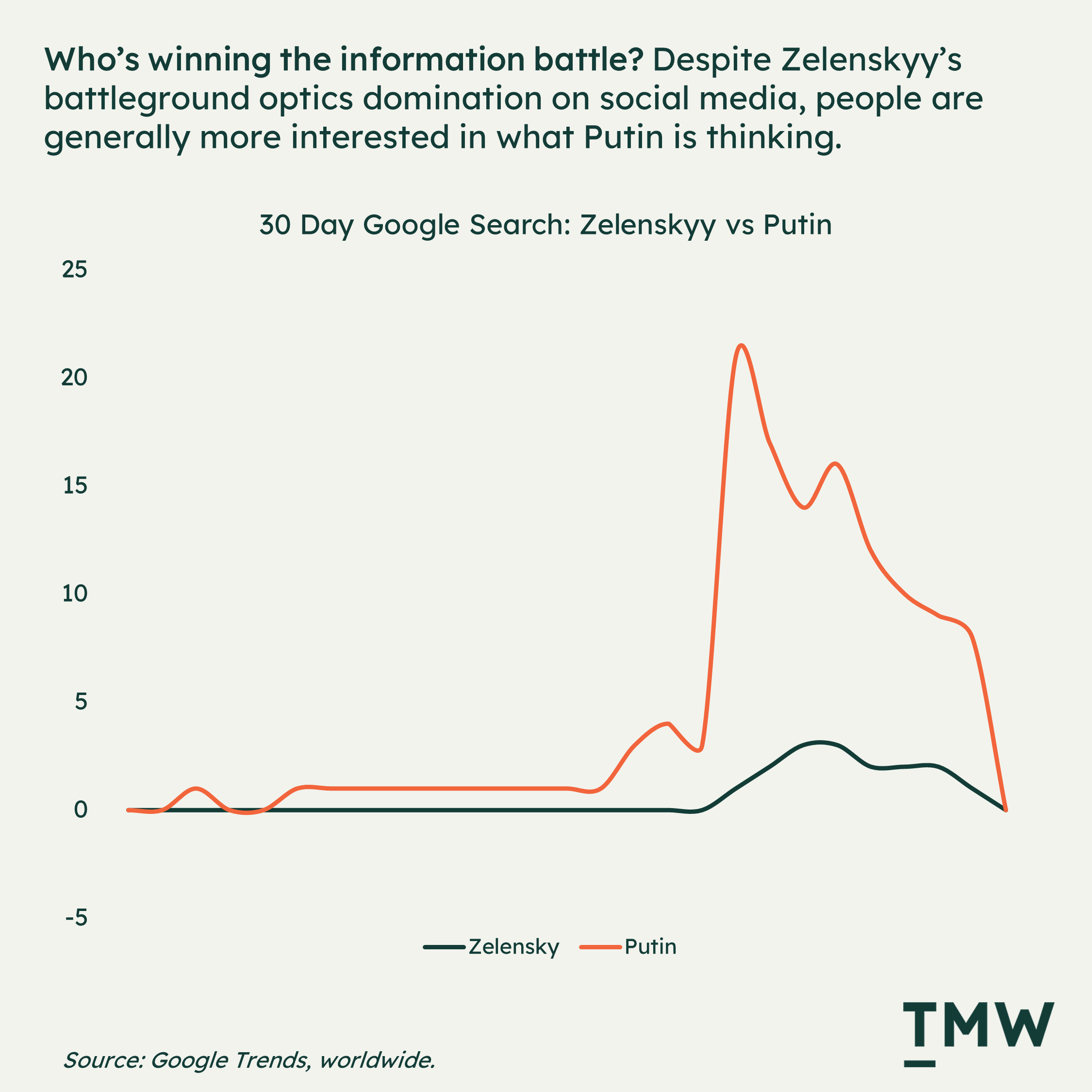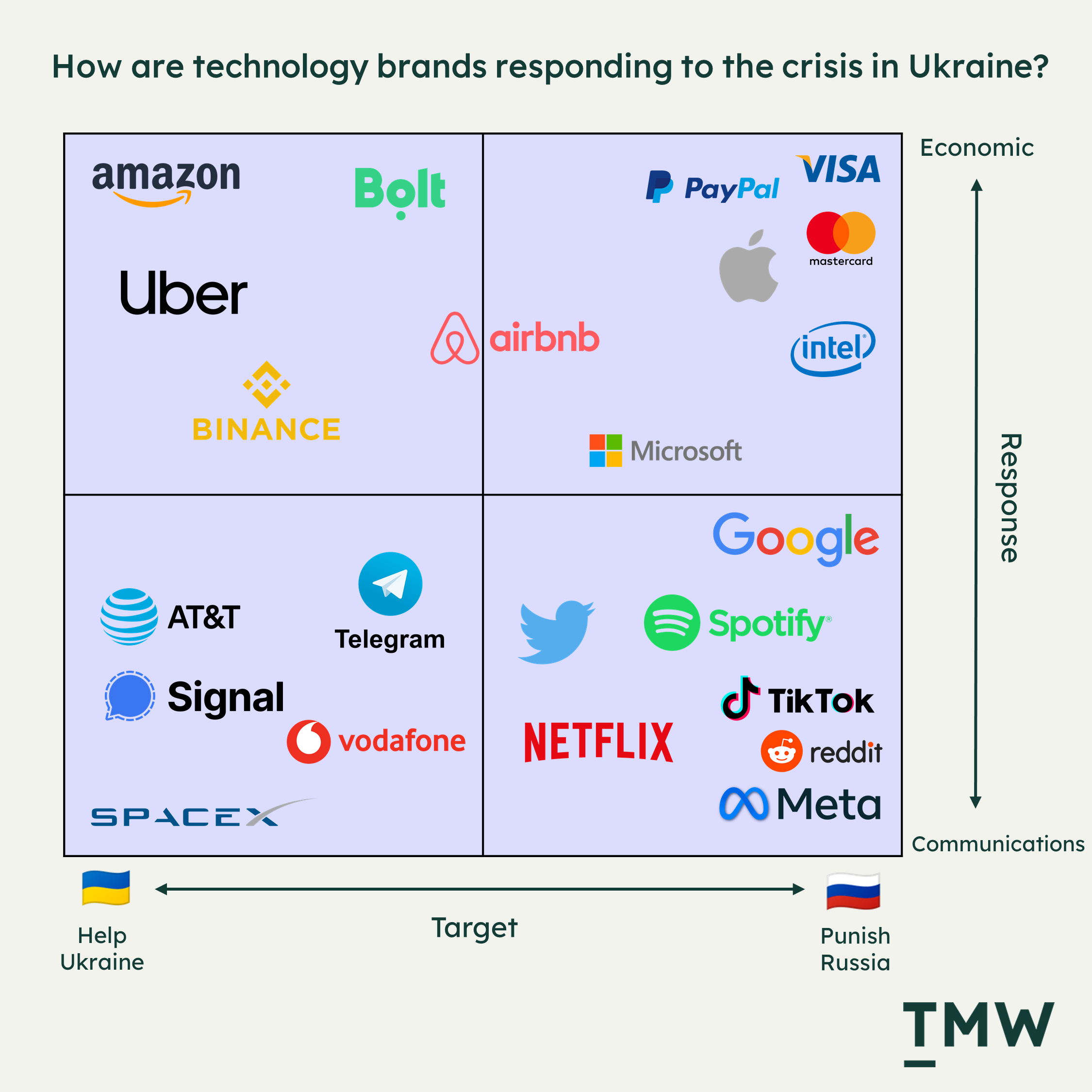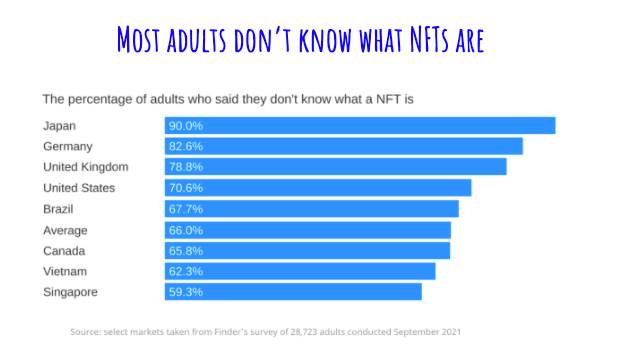TMW #075 | War augmentation in the age of marketing technology, do regular people know what an NFT is? The uncertain future of post-cookie technology.
Welcome to The Martech Weekly, where every week I review some of the most interesting ideas, research, and latest news. I look to where the industry is going and what you should be paying attention to.
👋 Get TMW every Sunday
TMW is the fastest and easiest way to stay ahead of the Martech industry. Sign up to get the full version delivered every Sunday for this and every TMW, along with an invite to the TMW community. Learn more here.
Before we get to this week’s edition of TMW, I have two programming notes:
1. A new Making Sense of Martech podcast episode is up. I speak with Kevin Tate, the Chief Revenue Officer at Clearbit about open data - what it is and how marketers use it. Link
2. There won’t be a TMW newsletter next week as I’ll be traveling! TMW will resume from the 20th of March. 🙏
Here’s the week in Martech:
● War augmentation in the age of marketing technology.
● Do regular people know what an NFT is?
● The uncertain future of post-cookie technology.
● Everything else: Illegal email, Apple’s digital ID, media as a service, Web3 dystopia, Martech and business performance, the periodic table of community marketing, and Kanye’s stem player strategy.
✍ Commentary
War augmentation in the age of marketing technology. How do we talk about marketing and technology when confronted by the prospect of war in eastern Europe? There are two ways of thinking about this question. The first is about how technology is augmenting the information environment, and the second is about the role of technology intervening directly in the conflict. There’s effectively an “air war” and a “ground war.”
Before I get into this question, it’s worthwhile pointing out that the overarching sentiment in the industry this week has been a sense of, to paraphrase Mark Ritson, that talking about marketing is both superficial and ridiculous. The situation in Ukraine means that lives and livelihoods are being lost, the threat of world war 3 is significant, and the total takeover of combat coverage across all media channels has flooded almost every online interaction.
It’s probably a fair enough assessment to say that people are probably not interested in marketing and tech news. But marketing technology is perhaps one of the most interesting forces that are augmenting what is playing out across Eastern Europe right now.
The reaction to the unfolding crisis in Europe from technology and marketing circles globally has been an interesting mélange of cringe-worthy virtue signaling, genuine efforts from brands to help, very strange marketing campaigns, content clashes between war scenes and advertising, and attempts to take advantage of the situation. Having a global health and military emergency wrapped in an information crisis and exacerbated by social media algorithms designed to maximize engagement results in many of us not being able to leave the constant, 24-hour firehose of wartime propaganda, human suffering, and combat footage. Exploding helicopters have always made great television.
This is what has made the entire week feel quite strange. A few examples highlight the strangeness of what is happening in the information environment. Ukraine’s official Twitter account is posting unhinged memes while also launching an NFT project that has so far raised millions in aid (but has subsequently failed to deliver actual NFTs). Pantone decided to dedicate a color scheme to Ukraine, while Elon Musk was organizing internet connectivity for the country over Twitter, and brands like Coke and Pepsi were called out by Ukrainian officials for not pulling out of Russia. We’ve also had brands carry on as usual to detrimental effects, like Applebee’s misplacement of a television ad right next to coverage of the crisis which came under criticism for the brand’s tone-deafness.
These examples are just a small sampling of the confusion that is unfolding as Russia invades Ukraine. It’s an uncomfortable conflict of information - brands wanting you to buy things side by side with regular people fighting for a country that might not exist tomorrow. On one side of the world we have extreme levels of comfort and prosperity and on the other, extreme violence and chaos.
Speaking with leaders in the marketing and technology industry this week there’s a real lack of clarity on what their brands should be doing in a wartime season. Should we pull ads? Should we donate to Ukraine? Should we carry on as if nothing’s happening? Should we publicly condemn Russia?
Most of this indecisiveness is driven by a combination of a generation never having experienced an international conflict unfold with this much coverage and seeing everything play out in real-time thanks to Twitter, Facebook, Reddit, TikTok, and Instagram. What we’re witnessing is one of the first real live-streamed wars.
The problem with social media is that it’s poorly equipped for situations like this. We have scenes of violence and suffering, strange wartime situations like tractors towing away tanks, blown-up buildings, and threats from Russia to activate their nuclear arsenal. This mixed with everything else like ads, cute puppy pictures, memes, posts from your friends makes for strange times when clearly this war content should probably not be experienced through social media channels which flatten every piece of information into a singular frame – the newsfeed.
This is partly why Ukraine is winning the information battle. Zelenskyy is deliberately posting live videos from the battlefield and photos and speeches surrounded by ordinary people fighting for their nation. This must be perhaps one of the most successful “marketing” campaigns we’ve seen in the 21st century. By spurring support from western organizations and demanding action against Russia with sanctions, the outcome is the biggest drop in Russia’s economy in a single day ever recorded. Most of Ukraine’s message was pushed through social media channels organically, direct to the audience.
Although It might seem like Ukraine is winning the “air war” on social media, who are people searching for on Google? Putin. I suspect this is because people are curious as to what is motivating him and what he might do next.

So how should brands navigate this situation? The answer is actually pretty simple: Help. Like Coca-Cola during World War II when they lowered the cost of products for service people, I’m seeing similar kinds of sentiments already working themselves out, but this time most of the “ground war”, the actions that directly change the course of events, are being driven by technology companies.
Apple and Microsoft have pulled out of all sales in Russia, while Mastercard and Visa are denying payment facilities. Facebook, Twitter, Spotify, TikTok, and YouTube took a softer approach by blocking Russian state media networks. These work as their own functional sanctions because the digital age has been a significant bridge for Russian citizens to the global economy. The technology giants own the infrastructure for the web which means they can respond in ways that resemble world governments and financial institutions.

While the world's largest brands level their own kinds of sanctions on Russia, smaller companies are doing what they can to support staff in Ukraine. You’d be surprised by how many technology companies have significant parts of their business working in digital, technology and marketing departments in Ukraine. Companies like Calendly, ahrefs, Big Commerce, Lyft, Grammarly, Wix, Cloudflare, Magento, and WhatsApp have had to shift from managing remote teams to becoming a critical line of support as Ukrainians put down their laptop to pick up AKS-74Us.
The reason for this is that Ukraine is becoming a digital powerhouse. Since 2012 the tech sector has grown from 0.8% to 4% of total GDP in Ukraine and is growing by more than 16,000 coders each year. Ukraine has historically been attractive for outsourced talent because of the industry’s reputation for high-quality technical skills, good English language, relatively low costs, and cultural alignment with the west.
Now, we’re seeing these CTOs, front-end devs, and product managers take up arms and head to the battlefield. This is both jarring and inspirational and a confounding experience for brands managing staff from the front lines. It's a strange thing to screenshots of JIRA tickets and Slack messages of Ukrainian team members asking for project extensions because they are spending most of their day blowing up tanks or in military skirmishes with the Russians. This is not normal.
One of the ways a brand can help in these situations is to invest more into the technology industry in Ukraine. There are plenty of Ukrainians who are finding asylum elsewhere or are living through this conflict and will need financial support. So much of the Ukrainian economy is disrupted that outside companies could be a helpful stopgap for many people who are financially stranded – now and well after the conflict is over.
At the end of the day, while an entire nation is fighting for their country, the people in marketing and technology teams have OKRs or KPIs to achieve this quarter. in other words, the marketing show must go on. The blinding reality is that for many this situation is far from over, is constantly changing, and is influenced significantly by the internet. The air war is playing out day to day, and post to post, and as sanctions and restrictions imposed by tech companies decimate Russia’s economy, there is one clear answer to how brands should respond to the crisis and that is to help. Links: Ukrainian IT industry overview. Mark Ritson on wartime marketing. The internet is a force multiplier for Ukraine. Apeing into war. The live-streamed war. Rethinking advertising during a war. List of tech companies taking action against Russia. Contextualizing Twitter coverage of Ukraine-Russia. In war, everything is content.
Over the next couple of weeks, I’m encouraging TMW subscribers to contribute to the situation in Ukraine. One of the best places to find trusted organizations to support is here.
📈Chart Of The Week
Do regular people know about NFTs? The short answer is no. Despite all of the hype over the past year in the emergent technology trend, the average consumer has no idea what they are. Given that the vast majority of NFTs are owned by less than 400,000 people, it’s hard to see any meaningful mass consumer adoption of the technology outside of the niches they are popular in today. Link

📰 Latest Developments
UID 2.0 is now blocked. IAB, the international organization that sets policies and standards across online tracking in digital advertising took on the administrator role of the next big technology that will replace 3rd party cookies – UID 2.0. The organization has now announced that it won’t be taking on this role until wider adoption of the tracking technology comes into the market. On the question of what will replace the cookie, it’s still a free-for-all. Link
Apple starts testing digital IDs. In a small number of US states, Apple is rolling out a digital version of a driver's license. This move is likely to have a significant impact on digital identity because as soon as it becomes mainstream, integration with service providers allows for one-click identity verification and a range of use cases that brands haven’t been able to explore previously. Link
Illegal email? A small story to come out of Singapore is an interesting thought experiment about how email might be regulated into the future. The country has announced that banks in Singapore will no longer be able to add links in emails sent to customers. This is partly to protect consumers from fraudulent communications, but it also turns email from a tactical channel to a brand channel overnight. Expect more of these kinds of regulations to happen elsewhere for companies that manage sensitive customer information. Link
📚 Reading
Media as a service. More media companies are being purchased by tech companies and financial institutions as a marketing strategy to hedge against increasingly expensive and limited content distribution pathways in social media, search, and display. Owning a media company creates a way to drive reach and build first-party data audiences while also creating independent subscription revenue streams. It’s the reason why companies like Stripe, Robinhood, Hubspot, and Zapier are all investing into the space. Links: CB insights report. Media innovation.
The web3 dystopia. The narrative around the crypto/blockchain/NFT/DAO space is changing. With many prominent academics publishing long and technical critiques of Web3 technology and debunking many of the claims of proponents, there has also been increasing fraudulent activity and many projects failing to live to the hype. It does make you wonder if there’s anything there “there.” Links: Web3 Dystopia. U.C Berkely professor Nicholas Weaver lecture. Web hype is naïve. Economist podcast discussing recent issues.
The unintended result of Apple’s privacy changes. ATT (app tracking transparency) changes to iOS have limited third-party tracking, but also have given significant market power to companies that have already collected vast amounts of first-party data. This then creates a strange asymmetry between these larger companies and advertisers that have traditionally relied on third-party trackers. Ad buyers are increasingly investing in what Eric Seufert calls “content fortresses.” Links: The profound, unintended consequence of ATT. Advertising beyond the walled gardens.
🔢 Data & Insights
The annual CDP report. Segment / Twilio’s annual CDP usage report looks at 25k customers and over 10 trillion API calls to understand trends in software usage and industry verticals. Growth in usage has slowed since the catalyst of COVID-19 induced digitization in 2020. Snowflake is now the fastest-growing app used with Segment CDP customers. Link
Martech capability and business performance. An interesting survey from Bain & Company and analyzed by Scott Brinker on the ways consumer brands are implementing marketing technology. Two things stand out: Brands that are leading in the market utilize a wide variety of Martech use cases. The companies that are successful in building Martech capability have also gained market share. Link
Email benchmarks. Gartner on email marketing performance ranking across industries. What’s interesting is that only 44% of marketers are using email to complement their digital strategies. When an email is used it’s in the bottom rankings for conversion effectiveness, behind paid search, event marketing, and even direct mail (!?). Link
💡 Ideas
The periodic table of community marketing. The emergence of the popularity of digital community building in the tech scene, particularly in the Web3 space over the past two years, has been significant. But what are the components of successful communities and how do they work? Link
Zoom’s contact center platform. As a cross-channel strategy, Zoom is building a contact center platform that enables businesses to facilitate interactions across SMS, web, video, and voice. This may be a step-change in thinking about customer service tech enablement. Link
An algorithm for wellbeing. What if algorithms can motivate people to do good things for themselves? Link
✨ Weird and Wonderful
The contagious diseases of social media. Atlantic research on how teenagers start developing turrets symptoms through watching influencers with the disability. Link
Kanye’s stem player strategy. Link
Salesforce employees say no to NFTs. Link
Stay Curious,
Make sense of marketing technology.
Sign up now to get TMW delivered to your inbox every Sunday evening plus an invite to the slack community.
Want to share something interesting or be featured in The Martech Weekly? Drop me a line at juan@themartechweekly.com.
